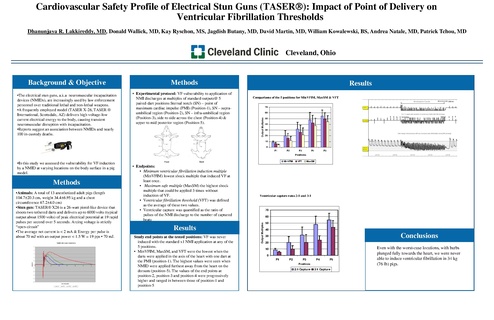Taser Cardiovascular Study Cleveland Clinic
Download original document:

Document text

Document text
This text is machine-read, and may contain errors. Check the original document to verify accuracy.
Cardiovascular Safety Profile of Electrical Stun Guns (TASER®): Impact of Point of Delivery on Ventricular Fibrillation Thresholds Dhanunjaya R. Lakkireddy, MD, Donald Wallick, MD, Kay Ryschon, MS, Jagdish Butany, MD, David Martin, MD, William Kowalewski, BS, Andrea Natale, MD, Patrick Tchou, MD Cleveland, Ohio •The electrical stun guns, a.k.a neuromuscular incapacitation devices (NMIDs), (NMIDs) are increasingly used by law enforcement personnel over traditional lethal and non-lethal weapons. •A frequently employed model (TASER X-26, TASER ® International, Scottsdale, AZ) delivers high voltage-low current electrical energy to the body, body causing transient neuromuscular disruption with incapacitation. •Reports suggest an association between NMIDs and nearly 100 in-custody deaths. M h d Methods • Experimental protocol: VF vulnerability to application of NMI discharges g at multiples p of standard outputs@ p @5 paired-dart positions Sternal notch (SN) – point of maximum cardiac impulse (PMI) (Position-1), SN – supraumbilical region (Position-2), SN – infra-umbilical region (Position-3), side to side across the chest (Position-4) & upper to mid posterior region (Position-5). Results Comparisons of the 5 positions for MinVFIM, MaxSM & VFT 70 60 Output Multiple es B k Background d & Obj Objective i 50 40 30 20 10 0 P1 P2 P3 P4 P5 Positions M h d Methods •Animals: A total of 13 anesthetized adult pigs (length 104.7±20.3 cm, weight 34.4±6.95 kg and a chest circumference 67.2±4.0 cm) •Stun gun: TASER® X26 is a 26-watt pistol-like device that shoots two tethered darts and delivers up to 6000 volts (typical output about 1500 volts) of peak electrical potential at 19 rapid pulses per second over 5 seconds. Arcing voltage is strictly “open-circuit” •The average net current is < 2 mA & Energy per pulse is about 70 mJ with an output power < 1.5 W = 19 pps • 70 mJ. MinVFIM • Endpoints: • Minimum ventricular fibrillation induction multiple (MinVFIM) lowest shock multiple that induced VF at l t once. least • Maximum safe multiple (MaxSM) the highest shock multiple that could be applied 3 times without induction of VF. • Ventricular fibrillation threshold (VFT) was defined as the average of these two values. • Ventricular capture was quantified as the ratio of pulses of the NMI discharge to the number of captured beats Results Study end points at the tested positions: VF was never induced with the standard x1 NMI application at any of the 5 positions. • MinVFIM, MaxSM, and VFT were the lowest when the darts were applied in the axis of the heart with one dart at th PMI ((position-1). the iti 1) Th The highest hi h t values l were seen when h NMID were applied furthest away from the heart on the dorsum (position-5). The values of the end points at position-2, position-3 and position-4 were progressively higher and ranged in between those of position position-11 and position-5 VFT MaxSM Ventricular capture rates 2:1 and 3:1 70 60 Output Multiples •In this study we assessed the vulnerability for VF induction by a NMID at varying locations on the body surface in a pig model. 50 40 Conclusions 30 20 10 0 P1 P2 P3 P4 P5 Positions 2:1 Capture 3:1 Capture Even with the worst-case locations, with barbs plunged fully towards the heart, we were never b e too induce duce ventricular ve cu fibrillation b o in 34 3 kgg able (76 lb) pigs.

